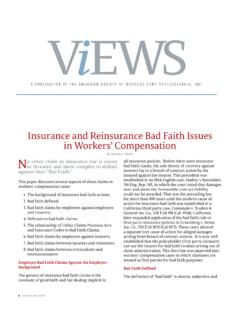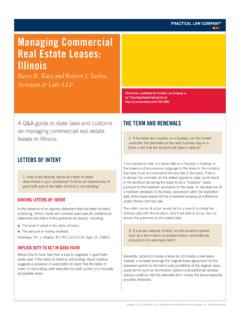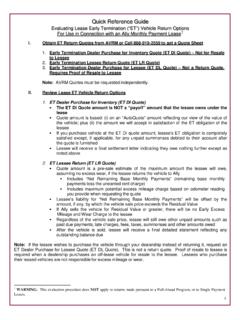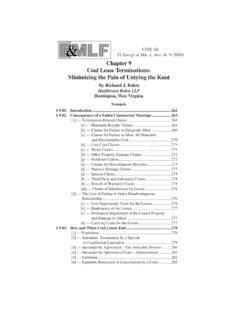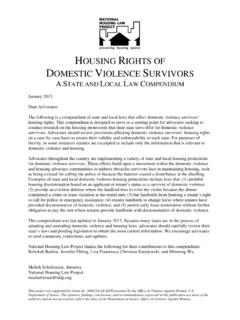Transcription of Adopting the Modern Trend: Mitigation of Damages in ...
1 12 In-House Defense Quarterly Fall 2015 RETAIL AND HOSPITALITY Leon Silver is co-managing partner of the Phoenix office of Gordon & Rees LLP. He is the leader of the firm s Retail & Hospital-ity Practice Groups and a member of the Commercial Litigation and Privacy & Data Security Practice Groups. He is co-chair of the Commercial Litigation and Commercial Leasing SLG of DRI s Retail & Hospitality Committee and co-chair of the Cybersecurity SLG of DRI s Commercial Litigation Committee. Andrew S. Jacob assisted with the research and preparation of this the Modern TrendThe commercial lease market has crashed once again and your retail landlord client has a tenant who pulls up stakes and abandons its lease . With an excess of unfilled space, your client doubts that it can re- lease the premises. What do you advise? No doubt that attorneys work-ing in the retail and hospitality industry have faced this question.
2 And the ques-tion becomes exponentially more difficult when dealing with a chain with loca-tions in many states. Be careful, because in many jurisdictions a landlord cannot make a claim for unpaid rent unless it made reasonable efforts to re- lease the premises to another common law, a landlord had no need to try to re- lease abandoned prem-ises. It could in effect do nothing and sue for unpaid rent because it had no duty to mitigate its Damages . See Restatement (2d) of Prop: Landlord & Tenant, (3) (1977) ( Except to the extent the parties to the lease validly agree otherwise, if the tenant abandons the leased property, the land-lord is under no duty to attempt to relet the leased property for the balance of the term of the lease to mitigate the tenant s liability under the lease , including his lia-bility for ).
3 In this article, we discuss why courts are Adopting the Modern trend view. We also discuss how courts address the burden to prove Mitigation efforts and we look at the kind of evidence that courts regard as prov-ing or disproving reasonable efforts. We begin with an actual Example of Commercial lease AbandonmentThe case begins when a restaurant tenant signed a seven-year commercial lease in mall space. When its business subsequently failed two years into the lease , the tenant abandoned the lease premises. Soon after, the landlord leased a portion of the aban-doned premises to another business. But a substantial part of the premises remained unleased. The record did not show what efforts, if any, the landlord made to lease the rest of the premises. It did not show, for example, whether the landlord engaged a broker or what the landlord did (if any-thing) to advertise the space for landlord sued the tenant, seeking as lost rental Damages the difference between the rent due from the tenant under the lease agreement and the rent that was received from re- leasing a portion of the premises.
4 When the tenant asserted a failure to mit-igate defense, the landlord argued that it had no such duty, that it had no obliga-tion to try to re- lease the premises. It also argued that, if it did have a duty to miti-gate Damages , in the absence of evidence of its efforts to re- lease , it should still prevail. Why? The landlord claimed that the tenant had the burden of proving that the landlord This common law view was predicated on treating a lease as a transfer of prop-erty rights rather than as a contractual exchange of promises:[L]eases have been historically recog-nized as a present transfer of an estate in real property. Once the lease is exe-cuted, the lessee s obligation to pay rent is fixed according to its terms and a landlord is under no obligation or duty to the tenant to relet, or attempt to relet abandoned premises in order to mini-mize Properties Ltd.
5 , v. Kenneth Cole Prods., 87 130, 133, 637 964, 966, 661 694, 696 (1995) (Inter-nal citations omitted). But over time many courts have abandoned that view. See Glen Weissenberger, The Landlord s Duty to Mit-igate Damages on the Tenant s Abandon-ment: A Survey of Old Law and New Trends, 53 Temp. 1 (1980).Currently, 28 states have abandoned the common law view and follow a vari-ant of the more Modern doctrine that a landlord must make reasonable efforts to mitigate its Damages when a commercial tenant abandons its lease . Under this mod-ern view, unless the landlord is unable to secure a substitute tenant after making rea-sonable efforts to do so, it is not entitled to sue for unpaid rent. Schneiker v. Gor-don, 732 603, 612 (Colo. 1987). Fifteen states (including the District of Columbia) continue to follow the no- Mitigation duty common law view.
6 Eight states have yet to take a position on this issue in a published of Damages in Commercial lease Abandonment CasesBy Leon Silver 2015 DRI. All rights Defense Quarterly Fall 2015 13failed to meet that duty because failure to mitigate was an affirmative defense. The trial court ruled in favor of the landlord, and the tenant Arizona Court of Appeals agreed with the landlord, ruling that the landlord did have a duty to mitigate but that this was an affirmative defense and the tenant failed to meet its burden to prove that the landlord failed to meet that duty. See Next Gen Capital, v. Consumer Lending Assocs., , 234 Ariz. 9, 12 13, 316 598, 601 (App. 2013) ( Because CLA was the breaching party, CLA ha[d] the burden of proving that Mitigation was reasonably possible but not reasonably attempted. ). In other words, although Arizona follows the Modern trend on Mitigation in this context, the tenant failed to prevail because it had the burden to prove that the landlord failed to , not all states that follow the Modern trend would have reached this result.
7 Had this case been decided under the law of states such as Illinois, Iowa, New Jersey, Oregon, or Utah, the landlord would have had the burden to prove that it made reasonable efforts to re- lease the premises. In those states, absent evidence of mitiga-tion, the tenant would have prevailed. So watch out! Modern TrendThe Modern trend is to view commercial leases as an exchange of promises, not much different than other contract rela-tionships. Wright v. Baumann, 239 Or. 410, 413, 398 119, 120 21 (1965) ( [A] Modern business lease is predominantly an exchange of promises and only incidentally a sale of a part of the lessor s interest in the land. ). Courts holding this view see no log-ical reason to treat a commercial lease dif-ferently than other commercial contracts:It is difficult to find logical reasons suf-ficient to justify placing [commercial] leases in a category separate and dis-tinct from other fields of the law which have forbidden a recovery for Damages which the plaintiff by reasonable efforts could have avoided.
8 The perpetuation of the distinction between such a lease and a contract, in the application of the prin-ciple of Mitigation of Damages , is no lon-ger v. Seglin, 184 Neb. 673, 677, 171 247, 250 (1969).As in other contract situations, these courts find compelling reasons to require landlords to try to minimize their dam-ages. See, , Sommer v. Kridel, 74 446, 457, 378 767, 772 (1977) (referring to the unfairness which occurs when a land-lord has no responsibility to minimize Damages ); Schneiker, 732 at 610 (ex-plaining that public policy favors the appli-cation of damage Mitigation principles because allow[ing] the property to remain unoccupied while still holding the aban-doning tenant liable for encour-ages both economic and physical waste ). Twenty- eight states have adopted this mod-ern trend view. See Table of Jurisdictions, infra. In five of these states (California, Del-aware, Illinois, Texas, and Wisconsin), the rule is set out in statute.
9 See Cal. Civ. Code (c)(1) (limits landlord s Damages by what the lessee proves could be reasonably avoided ); Del. Code Ann., 5507(d), Title 25 (holding in regard to residential leases, that the landlord has a duty to mitigate Damages ); 735 Ill. Comp. Stat. 5 ( [A] landlord or his or her agent shall take reasonable measures to mitigate the dam-ages recoverable against a defaulting les-see. ); , Property Code (a) ( A landlord has a duty to mitigate dam-ages if a tenant abandons the leased prem-ises in violation of the lease . ); Wisconsin Stat. ( [L]andlord can recover rent and Damages except amounts which the landlord could mitigate in accordance with this section. ).In the others, it is a judge-made rule. Why do other states resist the trend and stay with the common law view of a lease ? Two words: stare DecisisFew courts (if any) directly state that a commercial lease relationship should be governed solely by property law.
10 Yet many states, out of respect for stare decisis, con-tinue to follow the no Mitigation view that arose from such an understanding. At least fifteen states (including the District of Columbia) follow this view. See Table of Jurisdictions, Holy Properties, for example, the court explained:[P]arties who engage in transactions based on prevailing law must be able to rely on the stability of such precedents, and that in business transactions par-ticularly, the certainty of settled rules is often more important than whether the established rule is better than another or even whether it is the correct at states apply a mixed doctrine that lays all sorts of traps for the unwary. In these states, a lease relationship is treated as having both property and contract ele-ments. Property law controls the relation-ship if the lease is in effect and contract law with its requirement to mitigate Damages controls after the tenancy is terminated.

